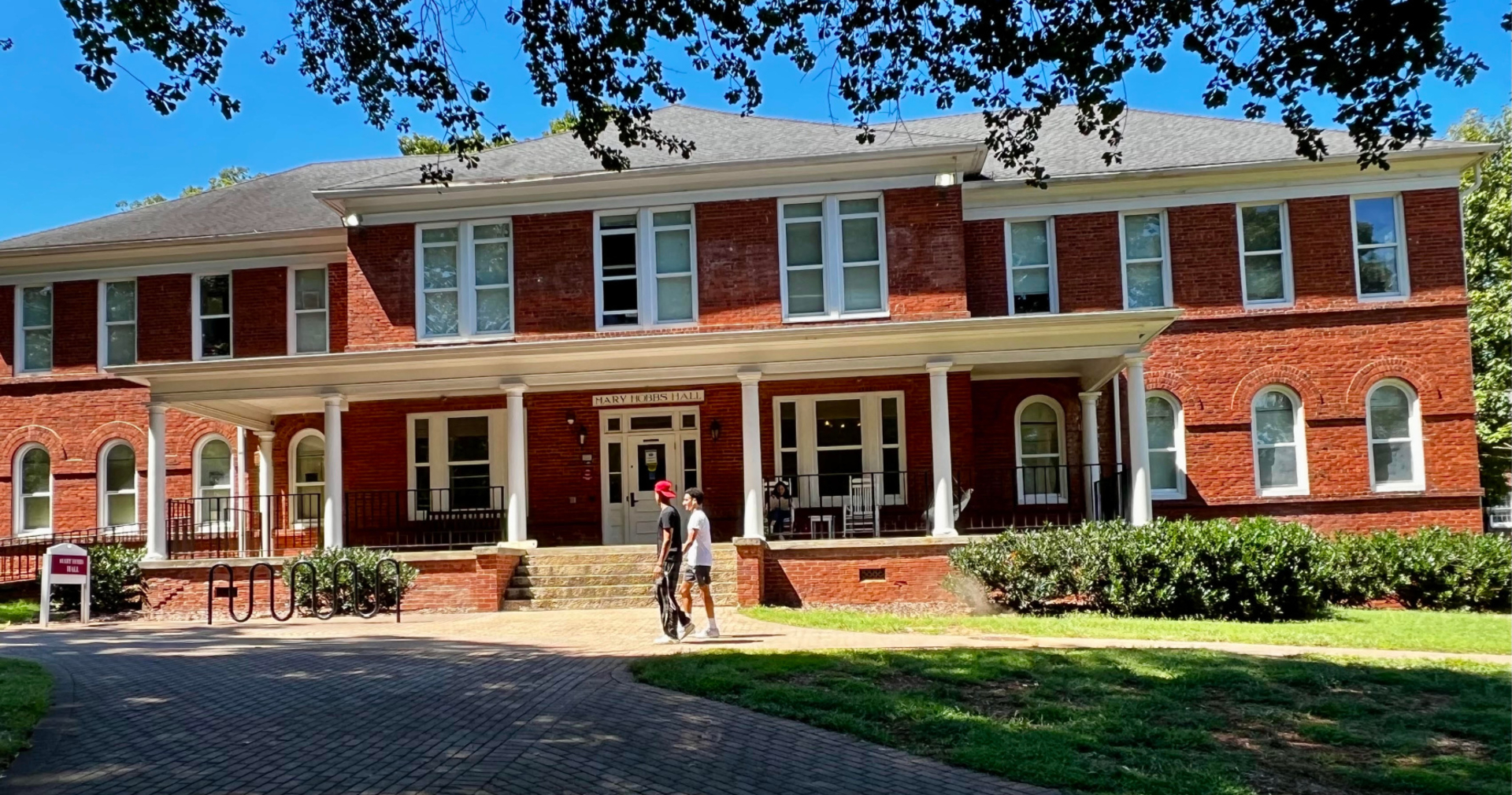
Mary Hobbs Hall
At last month’s Homecoming & Family Weekend, generations of Guilfordian women gathered to celebrate that grand old dame that is Mary Hobbs Hall.
“I never felt like I was living in a dorm. A dorm is a place where students sleep and study. Hobbs was a community. Everyone felt like they were there for each other.”
From her home across the road, Mary Mendenhall Hobbs needed only to glance out her bedroom window in 1907 to watch her legacy take shape. A half-made structure, its beams, columns and trusses rising bare from the Guilford campus. Soon it would be fortified with those iconic red bricks, prompting Mary to write of its grandeur: “The walls are about done and it does look beautiful.”
Later, Mary could barely contain herself, writing to a friend that the building that would one day bear her name “was not just so much brick and mortar, but the realization of our hopes and prayers, the result of our labors, the crown of our love…the house is a monument of loving kindness and good will.”
Is she embellishing now? Does it matter?
In September over Homecoming & Family Weekend, Mary Hobbs Hall celebrated its 115th anniversary. The oldest residential building on campus has endured attic fires, basement floods and four major renovations, but isn’t showing her age. Everyone agreed on that. The weekend was a wonderful chance for former “Hobbits,” as some of its residents proudly call themselves, to gather and swap stories that need no embellishing. Everyone also agreed on that.
As far as consensus goes, that’s about it. Nearly all the rest of Mary Hobbs Hall, as seen through the gauzy memories of its former residents, is uniquely colored by their own experiences, says Becke Blackwell Jones ’59. “I bet you could ask a hundred girls who lived in Hobbs what they remember most and get just as many different answers,” she says. “There was so much to remember.”
As Mary Hobbs turns a year older, it is natural to think of home-cooked dinners, giggling girls short-sheeting their roommates’ beds, and – gasp! – scantily-clad women showing off on the porch roof for male students below, but the dorm that looks over Guilford’s quad embodies so much more.
“I never felt like I was living in a dorm,” says Janice Lynch Shuster ’84, who lived in Hobbs her sophomore and junior years at Guilford. “A dorm is a place where students sleep and study. Hobbs was a community. Everyone felt like they were there for each other.”
From its inception, Mary Hobbs Hall has been a testament to women and learning. Mary was the wife of Lewis Lyndon Hobbs, the College’s first President. She was a lifelong Quaker educator, whose interest in the education of women was apparent early. When asked to write an essay on what she would do if given $10,000 to spend as she wished, Mary wrote about establishing a school for girls.
“That was something Hobbs believed in strongly,” says Gwen Gosney Erickson, Quaker Archivist and the College’s Special Collections Librarian. “There were many things Hobbs was very ahead of her time, very progressive in her thinking, and helping educate women was one she was passionate about.”
Mary insisted on New Garden Hall, the building’s original name until 1933, being a cooperative dorm. From its inception, students cleaned, shared laundry duties and helped prepare meals that were eaten together in the first floor dining room adjacent to the kitchen. In exchange for the cooking and cleaning, the women received a discounted housing rate.
As Gwen tells it, the dorm opened its doors when the Progressive Era was still in its infancy and parents weren’t inclined to spend too much on a woman’s education. A discounted dorm rate made that investment more enticing.
Linda Mercer ’69, who spent four years living and working in Hobbs, says there was an added bonus to living in a cooperative dorm. “When everyone’s cleaning together and singing songs while washing dishes and working toward a common goal you become family,” she says. “How can you not?”
Linda and her fellow “Hobbs Girls,” the name her generation of Hobbs residents gave themselves, still meet regularly to discuss all matters Guilford. “As soon as we see each other we just slide back into our old ways, hugging and greeting and teasing each other over lunch,” says Linda. “I don’t think you find that in too many other college dorms.”
Linda has a name for those bonds: friendship clumps. “There are clumps from the 20s, the 30s and 40s that continued to death,” she says. “Friends that stuck together, kept together, met together – still do. That’s the power of Hobbs.”
Janice, a proposal writer in Maryland, has two daughters. She tried to sell them on Guilford and Hobbs. “When I told them about (Hobbs) they said, ‘Mom, you make that place out to be some sort of utopia.’ They said it couldn’t have been that wonderful but it really was. I wish they had that chance to experience it.”
Alas, Janice’s daughters attended state schools in Maryland.
“That’s OK,” she laughs. “I’ll work on my grandchildren.”

